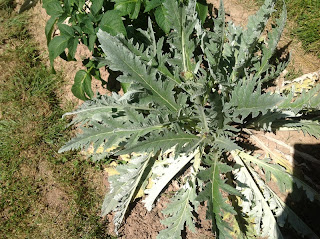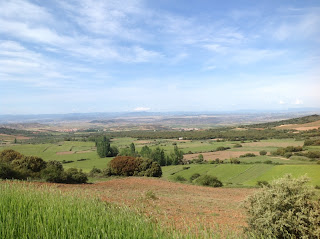We followed him up one street and down another.
 |
| We walked up the streets |
 |
| We walked down the streets |
 |
| Jose and Angela posing in front of the olive tree! |
 |
| Sue, Dotti, Sue Downs, and Sharon |
Then the mush is taken and put in flat baskets one on top of the other and pressed down allowing the oil to seep through the baskets.
Then the oil goes into the purifyer machine.
Then the oil is stored in the oil tanks.
We thanked the owner and filed out the door now more knowledgeable about how we get extra virgin wine! We were back out in the streets of Corera following the Father Cacarso. We saw old homes; we saw new homes; we saw a turkey farm.
An now we were going to find the mushroom man to see how he grows his mushrooms. We walked until we came to his house. Father knocked several times but no one answered. While we waited we posed for more pictures.
 |
| Father Cadarso knocked on the home of the Mushroom Man. |
 | ||
| Amy, Doug, Paula, and Kevin posing for pictures. |
We followed him to the back of his house where there were several quonset huts all stung out back of his yard. He went over and opened one door and let us in.
He gave the Mushroom Man a thumbs up and he got one back as well. We thanked him and walked back to the street where Father Cadarso was leading us to his boy hood home. Ed said that he wanted to show us his garden. So onward we would go. Soon we came to his door and met his sister who knew we were coming but still showed a bit of a shock watching fifty people trecking through her home heading to the garden in the back.
The garden was organized in tears because the home was on the side of a hill. The first level had fruit trees and one large fig tree. Then we climbed to the next level and found rows and rows of vegetables. It reminded me of my grandmother's garden in Palo Alto. We grew our own vegetables, and had peach, fig, and plumb trees. Everyone helped to plant and harvest the great food he had. My grandmother also canned fruit, and we had to help crack walnuts from her trees. This is when the Santa Clara Valley was the fruit garden of the world, and the fragrance of the flowers were like the Garden of Eden. Now the area is known as the Silicon Valley and you would find it hard to locate a fruit orchard! My grandmother's property is now a row of condos.
Here in this humble home the fruit trees were bearing fruit and the vegetables were plentiful!
 |
| Grape vine |
We left reversing our steps down the hill being careful to step of the paving stones. We said good by to Father Cadarso's sister and got back on the street. We looked up and there was a window full of young teen-agers who seem to be enjoying the parade of people in brightly colored polo shirts who were speaking English.
 |
| They looked like theyliked us! |
We left and walked back to where we had left the bus. Lucky Felix our driver, got to rest after the big meal and now he was ready to drive. We were told that we were going to see the big windmill on the hill which was our next bit of education. Everyone got on the bus and we left lovely Corera and headed east past lovely green rolling hills.
We were now in the area called Ocion. So we drove until we could see the windmill on top of a hill.
We climbed up and took pictures of the valley below.
We got out of the bus and it felt good to stretch our legs again. We saw an excavation sight and Father Cadarso said that it was the remains of the old wind mill. He said that the University of Rioja had done excavations and found that this ruin was what was left of the wind mill that had been there as early as the thirteen century
The earliest known windmills came from Persia around the seventh century, and their knowledge went east to China and India, and to the middle east then to Europe. It is found that the Moors brought knowledge to Spain. There are horizontal windmills which were used by the Moors for drawing and directing water and vertical windmills for the use in grain to flour production. This one seemed to be used for that purpose.
We all looked up at the sails of the wind mill that had the material tied down. It had an electronic device to do this so no one would have to climb up the lattice to do it. When there was wheat to grind, and the wind was blowing, the sails would be turned into the wind and the material part of the sail would be extended and the whole mechanism would begin doing its job.
We stood underneath to take some up close pictures of the sails.
We learned that it would cost a few Euros to go inside and have the guide tell us about the workings of the mill. Meg said she did not want to climb to the top of the windmill , so she paid for me to do it.That was fine. We went inside and read about windmills from the posters that surrounded the lower portion of the fist floor. This wind mill was built in 2006 and is a fully working piece of machinery.
The guide introduced herself in Spanish and RJ consented to be our translator. Our guide, Isabela, spoke very rapidly and RJ was doing his best to translate what she said.
I went inside to read about wind turbines because I had seen many of them in spain and quite a lot of them in the U.S. when I traveled across america last year. What I found amazing is the size of the single blade. It is the length of a blade is 100 meters or 330 feet. Almost the length of a football field! Last year we were driving in Illinois and a flat bed truck was transporting one of these blades right in the next lane in the highway. Our jaws dropped to see how long the blade actually was. They use Bernoullie's principle to turn, like an airplane wing by having air go faster over the top and lestening the pressure from below creating lift.
The purpose of the wind turbine is the convert wind into electricity.
We followed the guide inside and she showed us the grain as it is brought in by the farmers. The farmers pay to have their wheat ground.
She told us about the break wheel that turns by the use of the wind and how a gear attached to us turns the wallower gear that turned the grindstones. She would stop to see if RJ understood and wait until he translated the information to us.
 |
| Isabel waiting for RJ to translate |
 |
| RJ doing his best to translate information |
 |
| Grinding wheel |
 |
| Another view of the grindstone |



























No comments:
Post a Comment